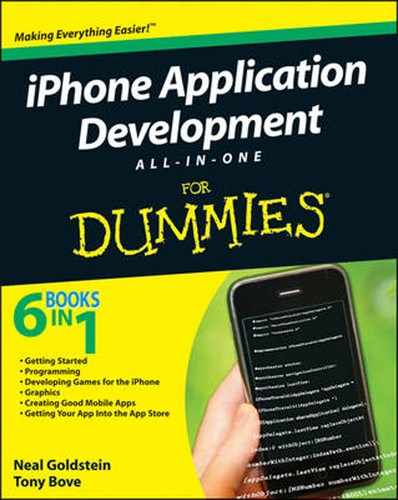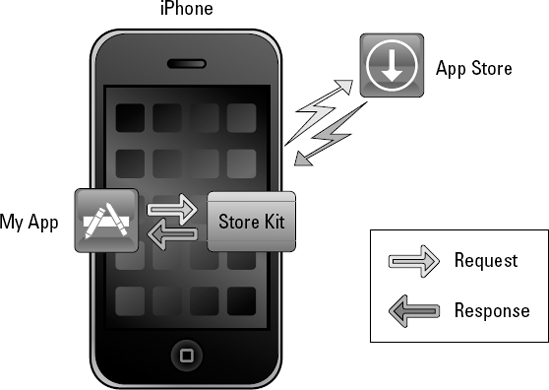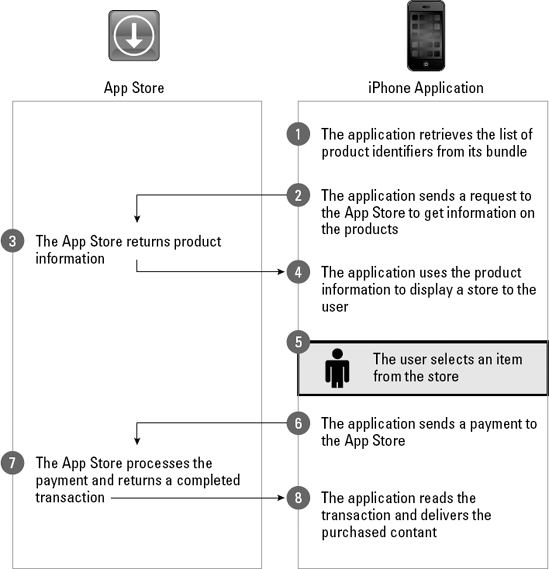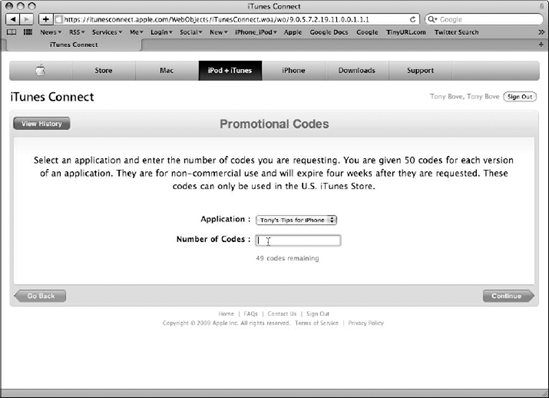Reaching potential customers
Measuring the success of marketing campaigns
Analyzing customer activity
Enabling in-app purchases
Making a business out of software development
Peter Drucker, known as the father of modern management, is also known for pointing out that business has only two functions: innovation and marketing. Because most of this book is about innovation, I need to spend at least one chapter explaining why so many developers don't make enough money from iPhone apps and what you can do to mitigate the complex issues surrounding the marketing of these apps.
Apple will list your application along with 100,000+ apps already listed in the App Store. Yes, it's wonderful that Apple takes only 30 percent of the sales price and takes care of hosting, downloading, credit card processing, and notifying users of updates. And if you remember the early days of developing for game machines, you may appreciate the fact that Apple lets you name your own price for your app. You can even distribute an app for free. What you can't do, and perhaps this is a good thing, is pay for preferential treatment. And as of this writing, Apple doesn't accept advertising within the store.
The App Store does offer lists of the top paid and free apps in each category and also lists the newest apps by release date, but unless your app is already successful and in the top paid or top free lists, your app's fleeting appearance in the list sorted by release date may provide only a short spike in sales — unless you prepare yourself to take advantage of it by applying some of the methods in this chapter.
The trouble with using any kind of technology to reach customers is the same, old or new: measuring the results. "Half the money I spend on advertising is wasted; the trouble is, I don't know which half," said John Wanamaker, founder of the first department store in Philadelphia (one of the first department stores in the United States) in 1861.
If you think the reason people buy apps is "because it's there" (that is, the App Store is right in your iPhone), you're only partly right. According to AdMob, more than 90 percent of iPhone users browse and search for apps directly on their mobile device instead of their computer.
But that doesn't explain why people flocked to the iPhone in the first place and continue to do so. Besides the fact that Apple has created an ecosystem and a platform for true innovation, the company has wasted no time using traditional advertising to lure people into buying things they didn't know they needed, with the well-known tagline "There's an app for that."
A major factor in the App Store's appeal is its equal treatment of all customers. This equal treatment is a fact of life today in all but the most posh stores, but it was an innovation in John Wanamaker's store in 1861. Wanamaker created the price tag because he believed that if everyone was equal before God, then everyone should be equal before price. (He also invented the cash refund and guaranteed the quality of his merchandise in print.) Apple has also established trust with its customers by screening apps before listing them and enforcing among app developers guidelines for a "quality experience" for consumers. And, of course, the price tag is right up front.
Speaking of a quality experience, people are attracted to new technologies just for the experience. Wanamaker embraced innovation as early as possible to attract customers with a new experience — his was the first department store with electrical illumination (1878), the first with a telephone (1879), and the first to install pneumatic tubes to transport cash and documents (1880). Today, people are attracted to the App Store's use of technology, its ease of use, and this highly innovative form of shopping-on-demand right from your phone.
There is no substitute for combination of trust, equal treatment, and a high-quality experience. The App Store is the place to list your apps. Marketing them, however, is entirely up to you.
The App Store is right at your customers' fingertips. The Store screen appears with Featured, Categories, and Top 25 buttons along the bottom, ready to entice potential customers.
The Featured screen (shown in Figure 7-1, left side) includes the What's Hot list of the most popular apps based on downloads and the New list of apps sorted by release date. The Featured screen is where the action is for early adopter customers who are buying on impulse. Your app will make a brief appearance in the New list when you release it, only to be crowded out almost immediately by more new apps. There are, by my rough estimates, about nine iPhone apps born in the App Store every hour of every day.
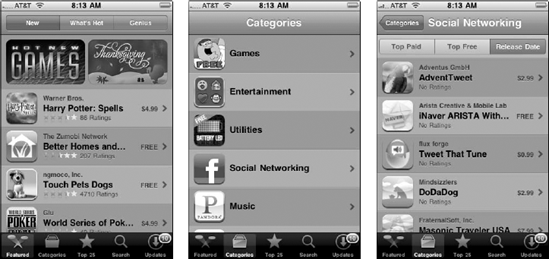
Figure 7-1. The App Store's Featured apps (left), Categories (center), and Social Networking category (right).
But if you've properly categorized your app, it should appear in the list of apps on the screen devoted to that category — in the Release Date list as soon as you release it. Attaching your app to the appropriate category, as I describe in Chapter 6 of this minibook, is extremely important. Customers looking for a social networking app tap the Social Networking category to find the Top Paid, Top Free, and Release Date lists. Your new app may last a bit longer in the Release Date list of your category.
The Top 25 screen is for those customers who need to catch up to the early adopters and only have time to look at the most popular apps in the Top Paid, Top Free, and Top Grossing lists. Your app will not reach these lists unless you've engaged in a successful marketing strategy.
Some customers will take the time to tap the Search icon to search the store, and they tap the entry field to bring up the onscreen keyboard. As they type a keyword you assigned to your new app, or something close to its name, your app should pop up right away as a suggestion. It is therefore extremely important to use an appropriate name for your app (with terms that people might search for) and to assign appropriate keywords, as I describe in Chapter 6 of this minibook.
Tip
Many developers choose to develop a free, or lite version, of an app to draw attention to the paid version. Free apps are more likely to be downloaded because, well, they're free. And according to AdMob, Upgrading from the lite version was the top reason given when users were asked what drives them to purchase a paid app.
Warning
Note, however, that the free lite version of your paid app must be a fully functional app, and can't reference features that are not implemented or point users directly to the full paid version. What this means is that, although you can publish a free lite app with fewer features than the paid version, the free version must be a complete app in its own right, and you can't badger the free app's users with reminders to upgrade to the paid version, nor can you use placeholders in your app's interface for missing functionality that, when tapped, points users to the paid version. Tricks like these will get your free lite app rejected.
Developers also have the In App Purchase feature at their disposal to offer their app users the opportunity to buy other apps, merchandise, game levels, premium features, books, and so on. (See the "Deploying the In App Purchase Feature" section, later in this chapter, for more.) You may also want to consider offering your customers an incentive, such as free deals through the In App Purchase feature, if they tell their friends about your app. Anyone browsing the App Store can tap the Tell a Friend button at the bottom of the app's information screen to send the app information in an e-mail.
Besides getting your app listed in the App Store's lists, there's no way through Apple to reach potential customers. You need to consider all methods of reaching customers, and you need to price your app according to what your target customer expects, which is a primary topic of Marketing 101.
The literature about marketing could probably fill all the Trump Towers in the world, but if you want to learn about marketing quickly, there are at least two apps for that. Marketing Master and MarketingProfs, both free in the App Store, walk you through the basic concepts, and while you certainly could do better by enrolling at Wharton (where the first Marketing 101 course was taught in 1909), it's a place to start.
Marketing is setting up a strong bait attraction system that generates leads, sorts those leads into qualified prospects, and then turns those prospects into customers. Besides fishing for the right prospects, you have to convince them to buy your app — in other words, "ABC, always be closing" (as Alec Baldwin so succinctly put it in the movie Glengarry Glen Ross).
One of the biggest lessons of Marketing 101 is to determine your target audience for your product. Assemble as much information about your target customer as possible — demographics, education, income level, and so on — because this information will influence all your marketing decisions, from the text you write in your descriptions and ads to the channels you use to distribute your message.
Another big lesson is to determine the cost of acquiring new customers. The simple math here is to divide all the dollars you spend in marketing per month by all the new dollars you receive each month in sales. When you know this, it begs the question of how much you should be spending. To figure that out, you need to know how much your customers are worth to you — the lifetime value of your customer. The secret to increasing the lifetime value of your customer is to increase the quality of the customer experience, thereby encouraging repeat business. You're not in the iPhone app game to do just one app; you need to develop more apps and build a customer base that will be happy to buy them.
Keep in mind that iPhone users download approximately ten new apps a month, according to AdMob, and those who regularly download paid apps spend approximately $9 on an average of five paid downloads per month. You need to attract the right people, not just anyone — potential customers are those who will understand the value of your app (also known as the value proposition, otherwise known as "what's in it for me?").
But at what price? Much has been written about iPhone app pricing strategies. At the beginning of this gold rush, pricing an app at $0.99 helped to get the app into the Top 100. But now, with over 100,000 apps, that's no longer true. All good marketers know that price is never a good selling point; anyone can come along and be cheaper. A better approach is to determine the true value of the app. People will pay for quality — and as more business apps become available, their prices will likely reflect their value.
The best approach is to check out similar apps, especially competing ones (if any). Remember how costly it is to acquire customers. Starting at a higher price gives you some room to offer discounted prices at different times, such as the Black Friday and Cyber Monday that follow Thanksgiving, or the start of the annual Apple Developer Conference.
One of the biggest problems facing the iPhone app marketer is that the App Store doesn't tell you who your customers are. Sure, you know how many customers you have, and you also know from which countries, and how many of them have updated your app (if you provided an update). You even know how much they spent. What you don't know, however, can hurt you. How can you possibly build relationships with customers you don't know?
The vast majority of apps downloaded from the App Store are in use by less than 5 percent of users a month after downloading, according to Pinch Media. Just 20 percent of users return to run a free application one day after downloading. As time goes by, that decline in usage continues, eventually settling below 5 percent after one month and nearing 0 percent after three months.
Tip
Category matters, too — games are used for longer periods than any other genre. Pinch Media found the long-term audience for the average app is just one percent of the total number of downloads.
So customer loyalty is hard to build. It's difficult to determine whether a user's positive experience with your app will translate into sales of your next app or your more expensive desktop app. There are no guarantees. You need to get as much data about your customers as you can find.
You may want to add a link to a Web page that offers an optional customer registration process. You could then ask questions during this process to get more information about your customer. You probably need to offer some kind of incentive to get your customers to register, such as credit toward an in-app purchase, or an exclusive service — for example, in my app Tony's Tips for iPhone Users, I offer registered customers access to a support forum in which they can ask me specific questions about using the iPhone.
You use iTunes Connect, which I describe in Chapter 6 of this minibook, to submit apps to the App Store and manage apps in the store. Apple releases daily sales reports in iTunes Connect, which you can view online or download, with the name of the app, how many were sold and in which country, and your profit. You can import these reports into any spreadsheet program, like Excel or iWorks Numbers.
To find the reports, log into iTunes Connect (as I describe in Chapter 6 of this minibook), and click the Sales/Trend Reports link. Doing so gets you shunted to the Transaction Reports page, which should look a lot like what you see in Figure 7-2. Pick Summary in the Report Type pop-up menu and then click Daily or Weekly in the Report Period pop-up — you can't pick Monthly Free unless your app is free. After picking your report, click Download to download it or Preview to view it.
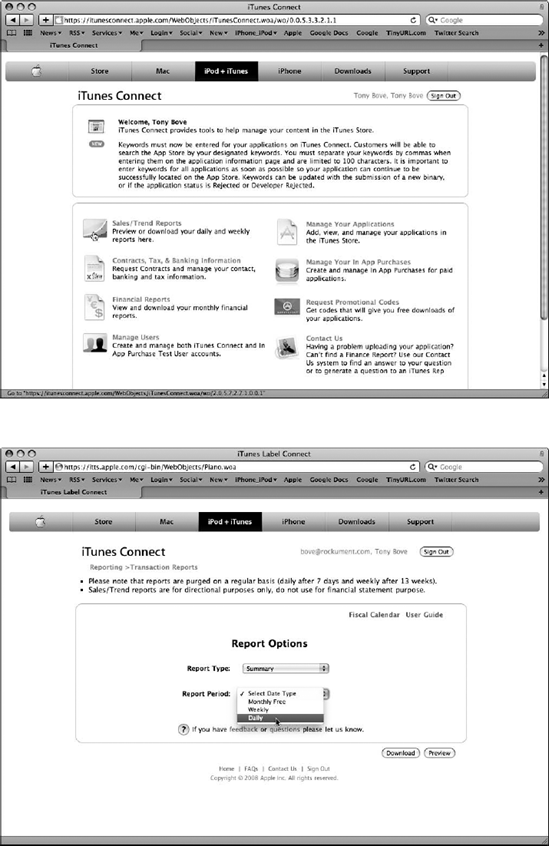
Figure 7-2. Visit iTunes Connect and click Sales/Trend Reports (top), and then pick the Daily or Weekly report (bottom).
Tip
Some savvy developers out there have come up with a number of desktop applications that have been designed to download and graph the iTunes Connect sales data for you. For example, AppViz (www.ideaswarm.com/products/appviz) is a Mac application that can import the reports from the Web or from a downloaded file, and it display charts of your daily, weekly, and monthly sales. AppFigures (www.appfigures.com) is a Web-based solution for tracking app sales that can download and graph your reports from iTunes Connect.
There are several analytics options for iPhone apps if you're willing to compile the necessary code into your app.
For example, Pinch Analytics from Pinch Media (http://pinchmedia.com), shown in Figure 7-3, is used in thousands of popular apps because it can track any action anywhere in your app. Armed with this information, you can fine-tune the user experience in your updates, and offer new features to try to catch usage drop-off as early as possible and retain more customers. You can also measure all types of revenue, from paid downloads and subscriptions to advertising and in-app purchases.
AdMob, recently acquired by Google, offers AdMob Analytics (http://analytics.admob.com), a service that works with your Web site to track customers that access pages on the site through your app. All you have to do is install a code snippet onto each page you want to analyze, and AdMob does the rest. When your app requests a page from your site, your server passes analytics-related data to AdMob, which processes your data and makes it available on http://analytics.admob.com. It can track the number of unique visitors and pages consumed on your site, and it can monitor user engagement metrics such as the length and depth of each visit.
Free apps can still generate revenue — by monetizing the app with advertisements. In much the same way as adding Google AdSense ads to your Web pages, you can add AdMob (now part of Google) or Mobclix (www.mobclix.com) ads to your apps.
Both are ad exchanges (like Google AdSense, by the way) that act as online marketplaces for buying and selling advertising impressions. Developers can earn income by placing space in their apps (known as inventory) in an auction for advertisers, ad networks, and agencies. The latter can maximize their click-through rates by bidding on precisely targeted audience segments. Thus, the more you know about your own customers, the more ads you can get for your app that are precisely targeted for more clicks (and therefore, more income).
For details about advertising on these networks, see the "Buying advertising and publicity" section, later in this chapter.
Apple offers the In App Purchase feature which developers can use in their apps. When incorporated, this feature enables the app users to purchase virtual items directly from inside the app. If you're developing a game app with multiple levels or environments, or virtual property, consider adding the In App Purchase feature to your app to sell more levels, environments, or property — the Eliminate app from ngmoco:) (yes, that's the developer's username) is a good example. If you're developing a book reader, use In App Purchase to sell books — Iceberg Reader 3.0 from ScrollMotion switched from selling books as separate apps to selling books through In App Purchase. Even if you're developing a productivity or travel app, you can deploy In App Purchase to sell additional premium features — Magellan RoadMate, for example, offers spoken street names and directions.
It's important to note that In App Purchase collects only payment. It doesn't download the book, add the game level, or hand over the virtual property. You need to provide the additional functionality, including unlocking built-in features or downloading content from your servers.
You put the In App Purchase store directly in your app using the Store Kit framework. (For more about frameworks, see Chapter 5 in this minibook.) The Store Kit framework connects to the App Store on your app's behalf to securely process the user's payments — see the model in Figure 7-4.
You use iTunes Connect to set up your products the same way you set up new apps. In App Purchase supports four types of products:
Content: You can offer game levels, virtual property, and characters; digital books and magazines; photos and artwork; in short, any content that can be delivered within your app.
Functionality: You can unlock or expand features you've already delivered in your app, such as a game that offers multiple smaller games for purchase.
Services: You can charge users for a one-time service, such as voice transcription — each time the service is used, In App Purchase processes it as a separate purchase.
Subscriptions: You can provide access to content or services on a subscription basis, such as a finance magazine or an online game portal. You're responsible for tracking subscription expirations and renewal billing — the App Store doesn't send out renewal notices for you.
Although the In App Purchase feature provides a general mechanism for creating products, everything else is up to you. You can't sell real-world goods and services, only digital content, functionality, services, or subscriptions that work within your app. No intermediary currency is allowed (such as a virtual world's currency), and you can't include real gambling (although simulated gambling is okay). And it goes without saying that pornography, hate speech, and defamation are not allowed.
In App Purchase divides the responsibilities of selling products between your app and the App Store, handling only the payment portion. Here's how it works (refer to Figure 7-5): Your app retrieves the list of product identifiers (set up with iTunes Connect) from its bundle, and the app sends a request to the App Store to localized information about the products. Your app displays this information so that users can purchase items. When a user elects to purchase an item, your app calls Store Kit to collect payment. Store Kit prompts the user to authorize the payment and then notifies your app to provide the items the user purchased.
This process is spelled out (in more detail than I can go into here) in the In App Purchase Programming Guide, which you can find in the iPhone Dev Center.
It goes without saying that you have a Web page (or entire site) devoted to your app, and you've outfitted your site with keywords for search-engine optimization so that searches in Google result in your Web page appearing on or near the first search page. You also use Google Analytics to measure traffic. Reams have been written on this topic. (See Web Analytics For Dummies for one particularly good use of such paper reams.)
When promoting an app, use well-written copy, good screen shots, quotes from user reviews, and third-party recommendations. If you have the skills or the budget, develop a quick video, upload it to YouTube, and put that on your page.
Tip
Don't forget to display prominently on your Web page the Apple-legal App Store button that links visitors to the App Store on iTunes. You can find the link to this button in the iPhone Developer Program Portal under App Store Resources.
But Web page links are not enough. The ecosystem of iTunes, the App Store, and the iPhone offers more than a few methods of reaching potential customers, as discussed in the following sections.
Your App Store links should make you some spare change as well as tell you a few things about your customers. The iTunes affiliate program gives you links to put on your Web pages. When a visitor clicks this link and then buys something in the iTunes Store (including the App Store), you get 5 percent. Although that's not much, it doesn't hurt. You can add affiliate links to any apps (or songs or videos) in the store, not just your apps.
You can put an affiliate link on your blog, on your friends' Web pages, and even in the signature of your e-mails. Anywhere that you would normally link to your app in the App Store, replace it with your affiliate link.
Another good reason to do this is to obtain more data. You can find out how often visitors see your links, what percentage actually click on your links, and where they come from. Apple uses LinkShare (www.linkshare.com), a fairly popular affiliate manager. LinkShare also manages affiliate programs for AT&T, LEGO, Macys.com, TigerDirect.com, and hundreds of other companies.
Users are your friends, even when they are bashing you in public.
The App Store customer review (see Figure 7-6) is one of the most valuable tools you have to convince potential customers to buy your app. Only people who have purchased your app can write a review. If you offer your users an optional registration on a Web site or by e-mail (using incentives such as insider news, discounts, or free stuff), you can use that opportunity to remind them to write a review of the app in the App Store.
Even harsh reviews can be helpful, pointing out bugs that you may have not previously uncovered, or offering ideas for additional features and functions you didn't think of. You should use this information to prioritize your development activities for future updates, and you can add information about fixed bugs in the app's description when you submit the update
Social networking spreads the buzz about your app. One of the most popular techniques is to publicize your app on dozens of forums including the iPhone Blog's Forum (http://forum.theiphoneblog.com), MacRumors Forums (http://forums.macrumors.com), or iPhone Fans (www.iphonefans.com).
It's a time-consuming job. Developers often turn to professional PR agencies that can put out press releases and work the blogs and forums for you. A good PR blast can drive thousands of sales within a few days. But beware: sales can fall off a cliff as new stories replace the old ones.
You should submit a press release about your app to the blogs and publications that directly serve your customers. You may not get attention for a paid app without also including a promotional code so that the reviewer can download the app for free. Apple gives you 50 promotional codes for each version of an app; use them wisely because there are far more than 50 general review blogs for iPhone apps, and there may be thousands of other blogs that serve your potential customers, such as travel blogs for customers of a travel app.
Warning
Remember that each promotional code you request expires four weeks after you requested it, so request only the number of codes you need at the moment. After you've submitted your app's information and promotional code to a few blogs, then go back and request more. These codes can be used only in the U.S. iTunes Store.
To get your promotional codes, visit iTunes Connect and click the Request Promotional Codes link. (Refer to Figure 7-2, top.) Then type the number of codes you need, as shown in Figure 7-7, and click Continue. iTunes Connect then provides the promotional codes to send in your e-mail or blog request. Reviewers already know how to enter promotional codes into the iTunes Store before buying an app.
I dislike having to mention this cheap trick, but many developers are still trying to take advantage of it, even though Apple watches out for it. The Release Date lists in each App Store category lists updates — so if you release updates often, these updates will be on that list more often, reaching more eyeballs.
The problem with this trick is that customers might be irritated by frequent updates. And if you try to publish an "update" that's nothing more than a facelift, Apple will most likely reject it.
Generating buzz through advertising is a time-honored tradition in marketing dating back to ancient times when Egyptians used papyrus to make sales messages and wall posters, and Roman emperors advertised military victories and public works on coins.
The coins are a good example: They were mobile, the image appeared often (at every transaction) to establish the "brand" of the emperor, and they cross-promoted other victories and public works.
Branding is a topic covered in grandiose detail in enough books to fill at least one Trump Tower. (Yup, there's even a Branding For Dummies.) Companies with very recognizable brands tend to make free iPhone apps to promote the brand. You may want to consider creating a version of your app that you could license or sell to a client company that then puts its recognizable brand on it. Such an arrangement is called a white label deal because the client company supplies the brand on the label.
If you are publishing more than one paid app, the first place to advertise your newest app is in your older apps — add links to cross-promote your other paid app. It costs nothing and helps to build customer loyalty, just because the customer can see that you've developed other apps.
Consider buying ads on other mobile networks that offer ads in iPhone apps. AdMob and Mobclix (described in "Putting ads in your app" earlier in this chapter) target iPhone apps and offer different ways to precisely target your ads. AdMob, for example, offers a video ad unit that runs a dedicated video player inside the app. The app's users can engage with interactive campaigns without leaving the video player. As the advertiser, you can also set up action buttons that let the app's users share video content with friends and connect to social networking sites — again, without ever leaving the video player. As an advertiser, you have a choice of auto-play or click-to-play: The former plays your video ads as soon as the app loads, whereas the latter requires the app's users to tap your banner in order to engage with the campaign.
Another popular choice is Google AdWords. You can reach anyone that searches on Google or on partner networks using any browser. There are close to a google of books available on this topic. (Well, almost 100; try AdWords For Dummies by Howie Jacobson.)
Publicity offers the biggest payoff in the short term, and the best way to get it is to pay an excellent PR firm. Good publicity can create a spike in sales that could be misleading, but if you've implemented other marketing campaigns to take advantage of it, sales could level out at a much higher rate than before the publicity hit. The best of the PR firms can help you with your entire marketing strategy.
But if you can't afford that . . . publicity stunts work well if received well by the public. Some of the world's most beloved annual events began their existence as cheap publicity stunts. In 1903, publisher Henri Desgrange started a bicycle road race as a publicity stunt to promote his newspaper, never imagining that the Tour de France would be going strong more than 100 years later. The Rose Bowl grew out of an 1`890 stunt designed to promote Pasadena, California, the Miss America pageant began in 1921 as a publicity stunt to lure tourists to Atlantic City after Labor Day, and the Academy Awards began in 1929 as a cheap publicity stunt for the movie industry. As Lenny Bruce put it, "Publicity is stronger than sanity: given the right PR, armpit hair on female singers could become a national fetish." (It did, about 15 years later.)
If you can generate publicity, be sure to have a demo on hand — something to titillate people whether they have their iPhones in hand or not. Create a video on YouTube and link it to your press release. Offer a free lite version of your app and time its release to occur at the start of the publicity campaign. Leave no stone unturned in looking for promotional opportunities as part of the campaign. And make sure your demo works — a sacrifice to the demo gods can't hurt. Or just keep repeating the mantra from the patron prophet of demos, Demosthenes: "Small opportunities are often the beginning of great enterprises."
